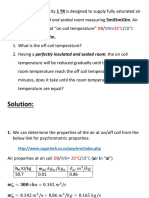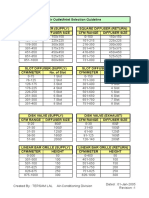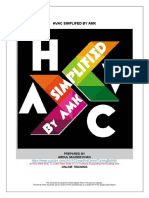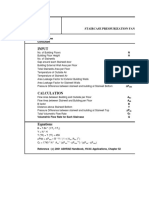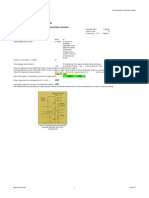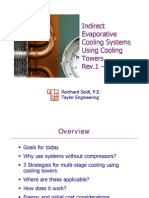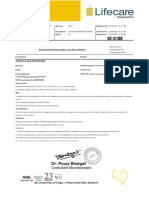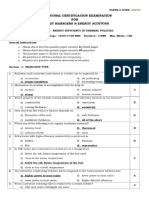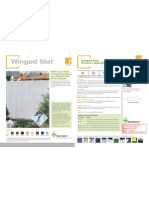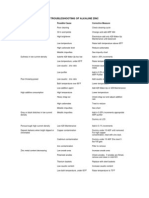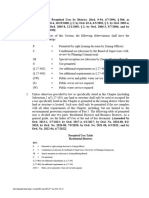Professional Documents
Culture Documents
HVAC Basics
HVAC Basics
Uploaded by
Mohamad ChaudhariOriginal Description:
Copyright
Available Formats
Share this document
Did you find this document useful?
Is this content inappropriate?
Report this DocumentCopyright:
Available Formats
HVAC Basics
HVAC Basics
Uploaded by
Mohamad ChaudhariCopyright:
Available Formats
HVAC BASICS
S.NO CONTENT PG.NO
Unit Conversion 2
1 Psychrometric Process and its 4
properties
2 Heat load 6
3 Refrigeration system & AC 9
Units
4 DUCT 16
Page 1 of 18 GSK HVAC EDITION
LENGTH
1000mm = 1m
1m = 100 cm
1m = 3.28 ft
1m = 39 inches
1ft = 12 inches
1ft = 0.30 m
1ft = 12 inch
1ft = 304 mm
1 inch = 25.4 mm = 2.54 cm = 0.0254 m
1 inch = 0.08 ft
AREA
1m2 = 1000000 mm
1m2 = 10.76 ft2
1m2 = 1550 inch2
1 ft2 = 144 inch2
VOLUME
1m3 = 35.31 ft3
1L = 0.001 m3
1m3 = 1000l
1cfm = 0.4719 L/s
1L/s = 2.118 cfm
1 CMH = 1/1.7 cfm
Ton
12000 BTU/Hr = 1 TON
1 TON = 3.516 KW
1 TON = 12 MBH
1 TON = 3025.9 Kcal/Min
Page 2 of 18 GSK HVAC EDITION
1 TON = 200 BTU/Min
1 KW = 3412 BTU/Hr
Mass
1 lbs = 0.453 kg
Temperature conversion
0 oC = 273 K = 32 oF
Fahrenheit to centigrade
o
C = 5/9 (oF - 32)
Centigrade to Fahrenheit
o
F = 9/5 x oC +32
What is HVAC?
HVAC stands for Heating Ventilation and Air Conditioning.
HVAC refers to the different systems used for moving air
between indoor and outdoor areas, along with heating and
cooling process.
Ultimate goal of HVAC is thermal comfort and indoor air quality.
Based on three principles,
Thermodynamics
Fluid mechanics and
Heat and mass transfer
There are three modes of heat transfer,
Conduction
Convection and
Radiation
Page 3 of 18 GSK HVAC EDITION
Psychrometric is the study of science ,which deals
with thermodynamic properties of air.
Process of psychrometric
1. Sensible heating,
2. Heating with dehumidification
3. Dehumidifying only
4. Cooling and dehumidifying
5. Sensible cooling
6. Evaporative cooling
7. Humidifying only
8. Heating and humidification
These are the 8 process of psychrometric.
Psychrometric properties
Dew point temperature (Saturated Air)
Relative humidity
Humidity ratio (or) Specific Humidity (or) Absolute Humidity.
Dry-bulb temperature
Wet-bulb temperature
Enthalpy
Entropy
Moist air
Page 4 of 18 GSK HVAC EDITION
Definitions
Dew point temperature is the temperature at which
moisture starts to condense out of the air. Dew point is also
know as saturation temperature.
Relative humidity is the ratio of actual mass of water vapour
in saturated vapour pressure
Absolute humidity or humidity ratio or specific
humidity is the mas of water vapour present in 1 m3 of dry air
and is generally expressed in terms of gram per cubic meter of
dry air (g/m3 of dry air)
Spec.humidity = water vapour (grams) / dry air(kg)
Dry-bulb temperature is the temperature of air recorded by
a thermometer, when it is not affected by the moisture present
in the air.
Wet bulb temperature is the temperature recorded by a
thermometer, when it’s bulb covered with a wet cloth exposed
to the air.
Moist air is a mixture of air and vapour. The amount of water
vapour present in the air depends on the absolute pressure and
temperature of the mixture.
Saturated air is a mixture of air and water vapour. The
amount of water vapour is in maximum level of the air, at this
condition air cannot absorb some more water vapour into it.
Page 5 of 18 GSK HVAC EDITION
Wet bulb depression is the difference between dry bulb
temperature and wet bulb temperature at any point. The wet
bulb depression indicates relative humidity of the air.
Dew point depression is the difference between the dry
bulb temperature and dew point temperature of air
Enthalpy H = U + PV
Entropy is DEGREE OF RANDOMNESS
A building or room gain heat from many resource. The sum of
all these heat sources is known as the heat gain of the building,
and is expressed either in BTU. For an air conditioner to cool a
room or building its output must be greater than the heat gain.
12000 BTU/Hr = 1 TON = 3.516 KW
Load factor:
Orientation of building
Exposed walls
Partition wall (negligible if both spaces are
conditioned)
Equipment
Lightning
Occupants
Window glaze
Roofs
Process taken
Infiltration and exfiltration (negligible)
Page 6 of 18 GSK HVAC EDITION
Dry bulb temperature and wet bulb temperature and humidity
ratio are the sufficient data for heat load calculation, with these
data you can find out the enthalpy.
Q = U A Δ(T)
Where ,
Q = Heat gain, BTU/Hr
U = Thermal coefficient , BTU/Hr oF ft2
ΔT = Temperature difference , oF
U = 1/R
Where,
R = Thermal resistivity, Hr oF ft2/BTU
We have to find climate data for where we gonna take heat
load. It may be a various country,state or continent too. We can
get details from ASHRAE standards.
ASHARE climate data 169
We can get climate data for some specific area from
this code of ASHRAE.
Or you can get weather data from ISHRAE Handbook Table 1.2
Take solar heat gain from ISHRAE tables.
Wall according to its orientation
Glaze table no - 1.8 (acc. To orientation)
Lightning power density table no - 1.38
Occupant load - 1.24
Page 7 of 18 GSK HVAC EDITION
Steps
1. Find U value
2. Take Project Summary ( Area, Occupants, LPD, Equipment,
Infiltration, Wall and Glaze which are exposed to direct
sunlight)
3. Calculate the difference in temperature of outdoor and
indoor(want to achieve)
If a wall had window , then it’s area should be reduce from
exposed wall area.
Have to find sensible , latent and total heat gain.
Sensible heat factor = sensible heat load / total heat load
Total Heat Load = Sensible Heat Load + Latent Heat Load
Sensible Heat :
Q = 1.08 x CFM x ΔTair (Btu/hr)
Q = 1.23 x L/s x ΔTair (W)
Latent Heat :
Q = 0.69 x CFM x Δw lb of H2O/lb dry air (Btu/hr)
Q = 3.0 x L/s x Δw gH2O/kg dry air (W)
Total Heat :
Qtotal = 4.5 x CFM x Δh (Btu/hr)
Qtotal = 1.2 x L/s x Δh (W)
Page 8 of 18 GSK HVAC EDITION
Air Conditioning is a process,which is used to
condition the air for what are all the properties actually we
need like moisture level, Temperature, Cleanliness and Air
distribution.
TYPES OF REFRIGERATION SYSTEM
Vapour compression refrigeration system
Vapour absorption refrigeration system
These are the two kinds, widely used for
refrigeration system.Among this two, VCRS is mostly used
system for refrigeration
TYPES OF AIR CONDITIONING UNITS
Direct expansion
Split unit
Fan coil
Variable Refrigerant Flow
Package AC
Window AC
Floor mounted unit
Roof top unit - AHU
Geo-thermal Heating & Cooling
Central Air Conditioners
Chiller plants
Air cooled Chiller
Water Cooled Chiller
Brine Chiller
VAM Chiller
AHU
Precision air conditioning
Page 9 of 18 GSK HVAC EDITION
Split and window air conditioners are used for small house or
buildings, which is not applicable for larger area, if it
happens ,cost may vary in huge.
Central air conditioner is used in larger places like Theater,
Hospital, Airport and Shopping malls etc.,
COMPONENTS OF AIR CONDITIONERS
Direct Expansion:
Evaporator coil
Condenser coil
Blower fan
Expansion valve
Compressor
Refrigerant
Expansion
Valve
Evaporator
Compressor
Fig 1. Vapour Compression Cycle or Refrigerant Cycle
Page 10 of 18 GSK HVAC EDITION
Variable Refrigerant Flow:
AHU CSU Cassette
Single outdoor unit can connected with multiple Indoor unit.
Indoor unit can be high-wall , cassette, fan-coil, AHU.
Controlled refrigerant is supplied in the evaporator unit as per
load requirement.
Both Split Unit and VRF is a Direct expansion units, but in Split
unit you cannot vary the flow of refrigerant and you can do
vary the refrigerant flow with variable refrigerant flow (VRF)
Unit. In some case, Using VRF unit to simultaneously heating
and cooling the space that we want to conditioning. Each
Conditioned Space having a thermostat, by the way each space
can be maintained separately.
Page 11 of 18 GSK HVAC EDITION
Chiller:
Air Cooled Chiller
Air Cooled Chiller
AHU AHU
Space Space Space Space
Space Space Space Space
CHILLER → AHU → SPACE
Advantage:
Cost is less ,because equipment is less.
Requires less place by means of , it can install over the roof.
Less maintenance required than WCC
Disadvantage:
Placed outside of building. ACC make noises,which may
affect nearby buildings
Exposed to atmosphere, So not able to give service as much
as WCC
Page 12 of 18 GSK HVAC EDITION
Water Cooled Chiller
Cooling Tower
Water Cooled Chiller
AHU AHU
Space Space Space Space
Space Space Space Space
COOLING TOWER →CHILLER→ AHU → TERMINALS
Advantage:
Water cooled chillers are more efficient, especially for larger
cooling loads.
Water cooled chillers provide longer service, because it is
inside of building.
Disadvantage:
Water cooled chiller installation cost is high.
Need constant and clean water flow.
Requires more spaces
Page 13 of 18 GSK HVAC EDITION
Compressor:
Reciprocating
Scroll
Screw
Centrifugal
Air Cooled chiller works under adiabatic heat exchange.
Adiabatic - there is only heat transfer and no mass transfer.
PRECISION AIR CONDITIONING
It is used in critical operation like server rooms
Especially, which are need high precision control in
temperature and humidity ,there we can install precision air
conditioning.
Example, IT hardware can produce high concentrated heat
load, it may very sensitive to temperature and humidity
change.
This may lead to huge cost expense for company
And this is made for 24*7 operation
Except precision AC , there is no AC to give precise
temperature and humidity
PRECISION:
SHF - 0.90 -0.99
80% - 90% sensible / 20% latent
CMF/TR - 600 -1000
Temperature - 20 +/- 1
Humidity - 50 +/- 5
Page 14 of 18 GSK HVAC EDITION
AIR HANDLING UNIT
AHU usually located in the basement, on the roof or
on the floors of buildings. AHU can serve load for specified area
or zone or perhaps a single purpose such as a building toilets.
AHU units condition and distribute the air towards building. AHU
take fresh ambient air from outside clean it, heat it, cool it and
humidification too and then forced through duct and deliver to
room through terminals.
It may has both supply duct and return duct.
COMPONENTS:
AHU housing
Cooling or heating coil
Fan
Filter
Panels
HEPA (High efficiency particulate air-filter)
Humidifiers
Page 15 of 18 GSK HVAC EDITION
Duct is a tube or passageway distributes the conditioned air to
the conditioned room.
Classification of ducts:
Supply air duct
Return air duct
Fresh air duct
Low pressure duct - 50mm
Medium pressure duct - 150 mm
High pressure duct - 150 to 200mm
Low velocity duct - Less than 600 m/min
High velocity duct - More than 600 m/min
Elbow duct
Trouser piece
Reducer/enlarger
Water gauge 1m = 9.81 kPa. 1mm = 10 Pa.
Materials used:
Galvanized iron sheet metal
Aluminium sheet metal
Black steel
Galvanized iron - thickness around 0.55 - 1.6 mm . Zinc
coating of this metal prevents rusting and avoids the cost of
painting.
Aluminium sheet metal - used because of lighter in weight
and resistance to moisture.
Page 16 of 18 GSK HVAC EDITION
Black sheet metal - always painted unless they withstand
high temperature.
Duct shape :
Circular, rectangular and square shapes.
Circular
carry more in less space
Less duct materials
Less duct surface
Less friction
And less insulation is needed.
Rectangular
Mostly preferred because it is flat surface, can design
convenient to room space and easy to work with it.
Square - may be preferred according to site condition
Pressure in ducts
The pressure of air must be greater than the
resistance to the flow, otherwise no air will circulate to the
space.
Static pressure
Dynamic or velocity pressure
Total pressure
Total pressure is the sum of static pressure and dynamic
pressure
PT =PS + PV
From, above condition we can overcome the pressure losses
caused by the various obstacles on the way from the fan to
conditioned space.
Page 17 of 18 GSK HVAC EDITION
Youtube channel : Discussion Zone
Page 18 of 18 GSK HVAC EDITION
You might also like
- HAP Head Load Calculations Inputs in UAEDocument1 pageHAP Head Load Calculations Inputs in UAEDesigner Forever100% (1)
- Calculation For Condensate Drain Water From Cooling Coil PDFDocument1 pageCalculation For Condensate Drain Water From Cooling Coil PDFJeghiNo ratings yet
- Pan Humidifier Load Calculation: Air Conditioning SystemDocument1 pagePan Humidifier Load Calculation: Air Conditioning SystemRamachandran Venkatesh100% (1)
- MEM05026C Apply Welding Principles - Learner GuideDocument25 pagesMEM05026C Apply Welding Principles - Learner Guidequestionbank.com.au100% (1)
- ASHRAE Duct Noise Vs VelocityDocument1 pageASHRAE Duct Noise Vs Velocityasdthu75% (4)
- MEP SITE - What Is FCU, AHU AND FAHU - PDFDocument5 pagesMEP SITE - What Is FCU, AHU AND FAHU - PDFAsan IbrahimNo ratings yet
- 39TC Installation and Maintenance Manual PDFDocument35 pages39TC Installation and Maintenance Manual PDFAngga HardiyantomoNo ratings yet
- York Chiller Log SheetDocument4 pagesYork Chiller Log SheetEngr Fazal AkbarNo ratings yet
- HVAC Beta Linear Slot Diffusers CatalogDocument14 pagesHVAC Beta Linear Slot Diffusers CatalogwissamnafoukhNo ratings yet
- Cooling Unit. Off Coil Temp Room Temp PDFDocument5 pagesCooling Unit. Off Coil Temp Room Temp PDFSundar Ramasamy100% (1)
- Humidification Load Calculator GuideDocument22 pagesHumidification Load Calculator GuideAnvar Pa100% (1)
- Diffuser Sizing GuidelinesDocument1 pageDiffuser Sizing Guidelinessyed mustafa aliNo ratings yet
- HVAC System Design Basis - AMKkkkDocument11 pagesHVAC System Design Basis - AMKkkkArvind Chaudhary100% (1)
- Staircase Pressurization Calculation SheetDocument4 pagesStaircase Pressurization Calculation SheetTariq AsgharNo ratings yet
- Supply Air Grille SizingDocument12 pagesSupply Air Grille Sizingdynamitedragon100% (1)
- Key Factors To Select FAHU: A Transfer of Knowledge & Expertise ....Document1 pageKey Factors To Select FAHU: A Transfer of Knowledge & Expertise ....Alihassan100% (1)
- Fcu PipingDocument20 pagesFcu PipingRamadan RashadNo ratings yet
- Carrier HAP Systems Design ReportDocument30 pagesCarrier HAP Systems Design ReportEngineering WavesNo ratings yet
- AHU InstallationDocument2 pagesAHU InstallationYazan AkNo ratings yet
- FireSmoke Control Stair PressurizationDocument10 pagesFireSmoke Control Stair PressurizationAshokNo ratings yet
- Stair Pressurization SystemDocument10 pagesStair Pressurization SystemPatel Kalinga100% (1)
- Chilled Water Flow, Pipe SizeDocument3 pagesChilled Water Flow, Pipe SizeSatya N.G100% (1)
- Heat Load Calculation ExampleDocument5 pagesHeat Load Calculation ExampleJoshua RanjithNo ratings yet
- HVAC ENGINEER Interview Questions Answers 1Document4 pagesHVAC ENGINEER Interview Questions Answers 1Sean HernandezNo ratings yet
- Hvac For AuditoriumDocument15 pagesHvac For AuditoriumkomalNo ratings yet
- Exhaust Fans Calculations & Sand Trap LouversDocument1 pageExhaust Fans Calculations & Sand Trap LouversAhmed HashimNo ratings yet
- EXHAUST FAN Static Pressure CalculationDocument15 pagesEXHAUST FAN Static Pressure CalculationCarlo Santi Bayabay0% (1)
- Linear Slot DiffuserDocument15 pagesLinear Slot DiffuserhyderabadNo ratings yet
- Air Changes Per HourDocument2 pagesAir Changes Per HourjjzoranNo ratings yet
- FAHUDocument4 pagesFAHUSundar DAAC100% (1)
- تقرير تدريب صيفي لواء الدين مظفرDocument23 pagesتقرير تدريب صيفي لواء الدين مظفرlalaNo ratings yet
- HRV DaikinDocument115 pagesHRV DaikinPityt CatalinNo ratings yet
- Fcu SizingDocument12 pagesFcu SizingLloydNo ratings yet
- All About AHUsDocument24 pagesAll About AHUsrahulNo ratings yet
- Coil Selection FormatDocument3 pagesCoil Selection FormatFarzanaShaikNo ratings yet
- Dehumidification in HVAC System p1 PDFDocument80 pagesDehumidification in HVAC System p1 PDFmanojc68No ratings yet
- 70 Most Important HVAC Interview Questions-1Document7 pages70 Most Important HVAC Interview Questions-1sergiu20No ratings yet
- Cooling LoadDocument16 pagesCooling LoadAbdul Razzak100% (1)
- HVAC Report FinalDocument50 pagesHVAC Report Finalsohail paracha100% (1)
- HVAC CalculationDocument2 pagesHVAC Calculationengrhabib07100% (1)
- Sumair Project Report PPT HVACDocument37 pagesSumair Project Report PPT HVACRishabh SinghNo ratings yet
- Chiller Diversity FactorDocument3 pagesChiller Diversity FactoraadsamudNo ratings yet
- Chiller Vs VRF PDFDocument26 pagesChiller Vs VRF PDFHenry San PedroNo ratings yet
- Precooled Ahu CalculationDocument3 pagesPrecooled Ahu CalculationEdmund YoongNo ratings yet
- Heat Loss and Gain CalculationDocument84 pagesHeat Loss and Gain Calculationafraz_xecNo ratings yet
- Stairwel and Lobby Pressurization CalculationDocument4 pagesStairwel and Lobby Pressurization CalculationLarry Bea75% (4)
- Calculo de CFM Pump Room Ventilation Calculation PDFDocument1 pageCalculo de CFM Pump Room Ventilation Calculation PDFsusansue50% (2)
- Lift Well Pressurization Calculation TOWER C - (G+17)Document4 pagesLift Well Pressurization Calculation TOWER C - (G+17)KoushikNo ratings yet
- Basement Ventilation CalculationDocument4 pagesBasement Ventilation CalculationShubhajit ChakrabortyNo ratings yet
- ASHRAE Duct Noise Vs VelocityDocument1 pageASHRAE Duct Noise Vs Velocityasdthu100% (1)
- AHU ChecklistDocument11 pagesAHU Checklistعزير القريشNo ratings yet
- Saiver Ahu 03Document3 pagesSaiver Ahu 03Farid SedekyNo ratings yet
- Heat Recovery Calculation SheetDocument3 pagesHeat Recovery Calculation SheetAnand sNo ratings yet
- COOLING Load Estimation ReportDocument72 pagesCOOLING Load Estimation ReportDikshit Tomer100% (2)
- Guide 1Document3 pagesGuide 1karimNo ratings yet
- Ahu Selection SoftwareDocument2 pagesAhu Selection SoftwareAkbar Khan 7118016No ratings yet
- Chilled Water Expansion TankDocument1 pageChilled Water Expansion TankRamiAl-fuqahaNo ratings yet
- Hospital Operating Theatre PDFDocument56 pagesHospital Operating Theatre PDFTajudeen Ibrahim80% (5)
- Square Foot "Rule of Thumb":: How To Estimate A Cooling Load (And Maybe Heating Load)Document7 pagesSquare Foot "Rule of Thumb":: How To Estimate A Cooling Load (And Maybe Heating Load)Arturo Del-RioNo ratings yet
- Cooling Tower InfoDocument78 pagesCooling Tower Infopitong_manning100% (1)
- القائمة الإلزامية للجهات الحكوميةDocument4 pagesالقائمة الإلزامية للجهات الحكوميةMohamad ChaudhariNo ratings yet
- Tender Spec in ArabicDocument37 pagesTender Spec in ArabicMohamad ChaudhariNo ratings yet
- Tender Spec in Arabic - Ar.enDocument37 pagesTender Spec in Arabic - Ar.enMohamad ChaudhariNo ratings yet
- RT-PCR - 2021Document1 pageRT-PCR - 2021Mohamad ChaudhariNo ratings yet
- Tender Spec in Arabic - Ar.en - Ar.enDocument37 pagesTender Spec in Arabic - Ar.en - Ar.enMohamad ChaudhariNo ratings yet
- 21stexam Paper2 Green PageDocument11 pages21stexam Paper2 Green PageMohamad ChaudhariNo ratings yet
- Circular 03Document4 pagesCircular 03Mohamad ChaudhariNo ratings yet
- ShahbuddinDocument1 pageShahbuddinMohamad ChaudhariNo ratings yet
- Energy Conservation in Cooling TowersDocument13 pagesEnergy Conservation in Cooling TowersMohamad ChaudhariNo ratings yet
- 75F Central Control UnitDocument2 pages75F Central Control UnitMohamad ChaudhariNo ratings yet
- OD125982418219175000Document1 pageOD125982418219175000Mohamad ChaudhariNo ratings yet
- Vistara - ConfirmDocument3 pagesVistara - ConfirmMohamad ChaudhariNo ratings yet
- Chiller Performance ParametersDocument3 pagesChiller Performance ParametersMohamad ChaudhariNo ratings yet
- Electrical Panel - Karjat RadissionDocument1 pageElectrical Panel - Karjat RadissionMohamad ChaudhariNo ratings yet
- Pexco PDS Winged Slat Product SheetDocument1 pagePexco PDS Winged Slat Product SheetprivacyslatkingNo ratings yet
- Unit RateDocument57 pagesUnit Ratetan ptNo ratings yet
- Fasteners Guide A4 20220102 WebDocument78 pagesFasteners Guide A4 20220102 WebAntonio LantiguaNo ratings yet
- Workshop - Casting Viva MaterialDocument3 pagesWorkshop - Casting Viva MaterialSnehasishNo ratings yet
- Catalogo OxweldDocument86 pagesCatalogo OxweldmekoxxxNo ratings yet
- JafzaDocument6 pagesJafzaMurugan RajaNo ratings yet
- Dynamic Analysis of Soil-Nailed SlopeDocument10 pagesDynamic Analysis of Soil-Nailed Slopejacs127No ratings yet
- GZB TMT DlrsDocument100 pagesGZB TMT Dlrskksingh007indiaNo ratings yet
- TANA Shark - Shredding Car and Truck TyresDocument2 pagesTANA Shark - Shredding Car and Truck TyresStefan EnacheNo ratings yet
- Grouser Bar 102521Document2 pagesGrouser Bar 102521MichaelMonguiNo ratings yet
- Straightening Vane Assembly Isometric View of Vane: Vane and Spool Piece DimensionsDocument1 pageStraightening Vane Assembly Isometric View of Vane: Vane and Spool Piece Dimensionsaamirtec301No ratings yet
- Standard ABS ProductsDocument9 pagesStandard ABS ProductsJ.C. LaugéNo ratings yet
- Troubleshooting of Alkaline ZincDocument3 pagesTroubleshooting of Alkaline ZincJOSE ANGEL CARRASCO50% (2)
- SDS R717Document10 pagesSDS R717e4erkNo ratings yet
- HPP - PAHF - Service ManualDocument13 pagesHPP - PAHF - Service ManualCátia RodriguesNo ratings yet
- Ffa 0e 250 Tlac40Document3 pagesFfa 0e 250 Tlac40mouniabzyazNo ratings yet
- DataDocument4 pagesDataQuế SươngNo ratings yet
- Xinhai EPCDocument21 pagesXinhai EPCmanuelgrillet3727No ratings yet
- Principles of Internal and External FixationDocument111 pagesPrinciples of Internal and External FixationTrần KínhNo ratings yet
- Straight Talk With Karen Scrivener On Cements, CO2 and Sustainable DevelopmentDocument4 pagesStraight Talk With Karen Scrivener On Cements, CO2 and Sustainable DevelopmentnamazuNo ratings yet
- DTC ChartDocument28 pagesDTC ChartMarcelo LealNo ratings yet
- Export Sample ReportDocument16 pagesExport Sample Reportaarzu.aliro1No ratings yet
- Table of Permitted Uses by DistrictDocument19 pagesTable of Permitted Uses by DistrictLVNewsdotcomNo ratings yet
- Epilux 58 M.I.O.: Product DescriptionDocument2 pagesEpilux 58 M.I.O.: Product DescriptionMoin AltafNo ratings yet
- TIBOX Catalogue 2012Document50 pagesTIBOX Catalogue 2012Anthony BarbachanNo ratings yet
- ACS 600 Hardware ManualDocument82 pagesACS 600 Hardware ManualJaya AdiwigunaNo ratings yet
- Valeo SVA - Special Vehicle ApplicationsDocument4 pagesValeo SVA - Special Vehicle ApplicationsAbishek AbhNo ratings yet
- Casting & ForgingDocument42 pagesCasting & ForgingMrinal100% (1)










